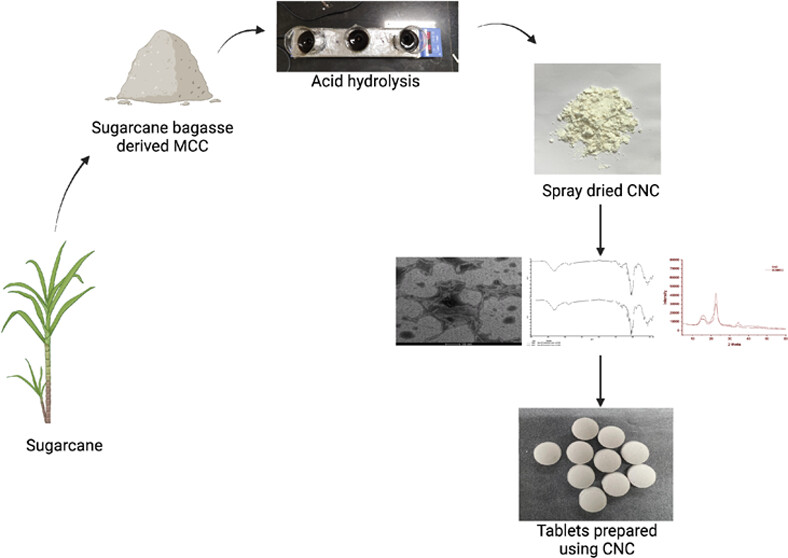New Excipient For Oral Drug Delivery: CNC Derived From Sugarcane Bagasse-Derived Microcrystalline Cellulose

Abstract
Nanocrystalline cellulose (CNC) has emerged as a subject of researcher’s interest because of its diverse attributes encompassing biocompatibility, sustainability, a high aspect ratio, and an abundance of −OH groups suitable for modifications. Sugarcane bagasse microcrystalline cellulose (SCBMCC) was used as the raw material for the preparation of CNC due to its pure cellulose content, which is mildly compromised by the pectin, hemicellulose, lignin, and other lignocellulosic components. In the present work, CNC was extracted from SCBMCC and used as a disintegrant. The classic hydrolysis technique was used for the preparation of CNC. Hydrolytic conditions were optimized using the response surface methodology (RSM). The optimized batch of CNC was characterized using techniques such as field-emission scanning electron microscopy (FESEM), transmission electron microscopy (TEM), X-ray diffraction (XRD), and attenuated total reflectance Fourier transform infrared (ATR-FTIR) spectroscopy. Notably, CNC prepared under a hydrolysis time of 90 min exhibited the highest crystallinity of 69.9%. The average particle size and zeta potential were found to be 145 nm and −34.4 mV, respectively. Thermal analysis suggested that an intermediate hydrolysis time resulted in CNC with enhanced thermal stability, showcasing its potential for pharmaceutical applications. Diclofenac potassium was used as the model drug to evaluate the disintegrant properties of CNC as an excipient. Tablets were prepared using the direct compression method. SCBMCC and CNC were used as disintegrants and were compared with the commercial product. The disintegration times (DTs) attained for the tablets prepared using CNC and SCBMCC are 219 and 339.83 s, respectively. The dissolution study of CNC showed a dissolution efficacy (DE%) of 66 and a mean dissolution time (MDT) of 12. The research findings showed that tablets prepared using CNC as disintegrants exhibited the fastest disintegration compared to other formulations.
Introduction
Cellulose is one of the most inexhaustible natural polymers, which is widely present in the cell walls of all fibrous plants, algae, and oomycetes. Cellulose fibers can be isolated from wood (softwood and hardwood) and nonwood plants (agricultural waste), and it consists of 50–60% cellulose, 20–30% hemicellulose, and 10–25% lignin. (1) Cellulose, hemicellulose, and lignin are collectively known as lignocellulosic biomass. Cellulose is a homopolysaccharide consisting of β-d-glucopyranose units joined together by β-1,4-glycosidic linkages. (2) The degree of polymerization ranges from 10,000 to 150,000 depending on the source. (3) Hemicellulose is a branched polysaccharide that is structurally homologous to cellulose because it has a backbone composed of 1,4-linked β-d-hexosyl residues. (4) The units of lignin formation are guaiacyl(G), syringyl(S), and p-hydroxyphenyl. The three major pathways involved are as follows: the shikimate pathway, the phenylpropanoid pathway, and the synthesis of monolignols. (5) Cellulose is abundantly present in crop residue and fruit residue and is even obtained from different waste such as filter paper, newspaper, tetra pack, cigarette filter, and tea powder waste. (6)
India’s diverse agro climate encourages the cultivation of numerous crops, including medicinal herbs, ornamental plants, decorative plants, vegetables, trees, root tubers, spices, and plantation crops. India is the second largest producer of fruits and vegetables in the world. (7) Lignocellulosic biomass is produced on a large scale yearly during harvesting, cultivation processing, and consumption of agricultural products. Sugarcane is the richest source of sucrose and plays a major role in sugar production globally. India is one of the leading countries in the production of sugarcane. Various states in India produce sugar as the first major crop for commercial purposes. India currently ranks second in cultivation area (5.11 million ha) and sugarcane production (303.83 million tons) next to Brazil. The number of sugar mills operating in India expanded from 29 to 520 within a year (1930–31), increasing the country’s annual sugar output from 0.12 million to 34.97 million tons in 2022–24. (8) Large production of sugarcane has led to a high level of waste generation. In the past two decades, researchers have taken a keen interest in the utilization of waste in the nanoform for drug delivery, tissue engineering, and as a polymer matrix for nanocomposite films. (9,10)
The focus on renewable energy sources is obvious due to the concerns related to the use of fossil fuels and the ensuing greenhouse effect. (11) In this regard, agricultural waste is a promising source. (12,13) In addition, various waste products of agricultural origin have been used as raw materials for extracting industrially useful products, such as sugarcane bagasse microcrystalline cellulose (SCBMCC), nanocrystalline cellulose (CNC), and others. Sugarcane (Saccharum officinarum; Family: Poaceae or Gramineae) is a tall perennial plant that grows erect up to 5 to 6 m in height. It has four parts: root system, stalk, leaves, and inflorescence. It is cultivated in tropical and subtropical countries worldwide for the production of jaggery, sugar, and ethanol. Out of 195 countries, 24 are actively involved in sugarcane production. As of 2019, sugarcane production in India was 34,300 tons, accounting for 24.47% of the world’s sugarcane production. Every year, these industries produce a large amount of byproducts such as sugarcane bagasse, dry leaves, sugarcane molasses, and sugarcane press mud. Bagasse is composed of 45–60% cellulose, 20–25% hemicellulose, 18–24% lignin, 1–4% ash, and less than 1% wax on a dry basis. Every year, a large amount of agricultural waste is collected around the globe. (14) For producing sugar from 10 wet tons of sugarcane, the industry collects 3 wet tons of sugar fiber waste, which ultimately causes environmental pollution if thrown in the open. (15,16) Given the scale, sugarcane bagasse is one of the most lucrative options for extracting cellulose without environmental concerns.
Various agricultural sources have been used for the extraction of microcrystalline cellulose (MCC) and CNC. Hasanin, Kassem, and Hassan prepared microcrystalline cellulose from olive stone using an acid hydrolysis technique. The prepared MCC was characterized using various techniques such as ATR-FTIR spectroscopy, TGA, XRD, and SEM. The prepared MCCs were compared with commercial MCC (Avicel 101), and the results showed good agreement in most properties between olive stone MCC and commercial MCC. (17) Kian, Jawaid, Ariffin, and Alothman used roselle fiber for the preparation of MCC by acid hydrolysis technique and obtained a yield of 29.7%; they prepared polylactic acid nanocomposites and used them for pharmaceutical applications. The MCC was purified, and partially depolymerized cellulose was prepared from bleached Kraft wood fiber, resulting in the existence of an amorphous part also in the structure, which gave flexibility to it and made it different from other types of CNC. The particle size of the MCC ranged from 10–50 μm to hundreds to thousands of microns in length.
Preparing CNC from MCC has gained considerable attention because of its pure cellulose content, which is less compromised by hemicellulose, lignin, and waxes. (18) Prathapan, Thapa, Garnier, and Tabor prepared the CNC aqueous suspension from MCC and worked on zeta potential modulation based on different pH conditions with different concentrations of inorganic, organic salts, and surfactants to understand the correlation between the zeta potential and the roughness of CNC. Results depicted that ions and electrolytes offer an important way to control stability and film properties. (19) Cao, Huang, Li, Xu, Wu, Li, Lou, and Zong prepared biocompatible magnetic CNC (MCNC) by a simple coprecipitation crosslinking technique for the immobilization of lipase enzyme from Pseudomonas cepacia lipase (PcL). Results showed that PCL@MCNC was capable of effective catalysis, with a high yield of 43.4% and an enantiomeric excess of 83.5% of the product. (20)
Nanocellulose is a nanomaterial extracted from natural cellulosic materials. Cellulose nanocrystals are rigid rod-shaped crystals having a diameter of 5–10 nm and a length of 50–300 nm. (21) Unique properties of nanocrystalline cellulose such as biocompatibility, biodegradability, a high Young’s modulus, high tensile strength, large surface area, and greater availability make nanocellulose significantly more different from other polymers. Size reduction is always a favored way to increase the surface area of a particle. An increase in the surface-to-mass ratio can enhance their performance. (22,23)
Because of the absence of a standardized nomenclature, the nanocellulose literature employs various terms to explain cellulose particle sets. The cellulose-based particles are classified into three different categories, which often vary from one another depending on the cellulose source materials and the extraction technique. Nanocellulose collectively represents multiple particle forms, including NFC, CNC, and BC, having a minimum of one dimension at the nanoscale. (24)
Download the PDF here :New Excipient For Oral Drug Delivery
or read it here
New Excipient For Oral Drug Delivery: CNC Derived From Sugarcane Bagasse-Derived Microcrystalline Cellulose, Shweta Mishra, Cite this: ACS Omega 2024, Publication Date:April 18, 2024, https://doi.org/10.1021/acsomega.4c00497, © 2024 The Author. Published by American Chemical Society. This publication is licensed under, CC-BY-NC-ND 4.0.


